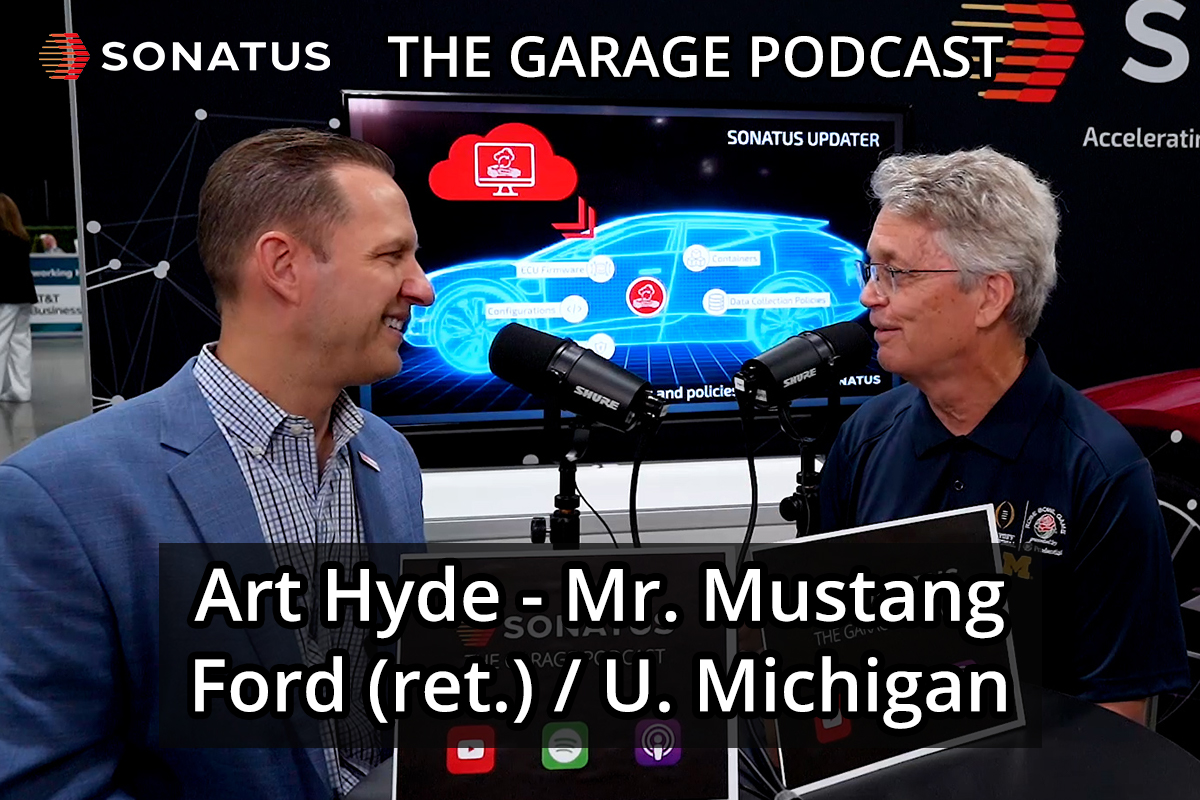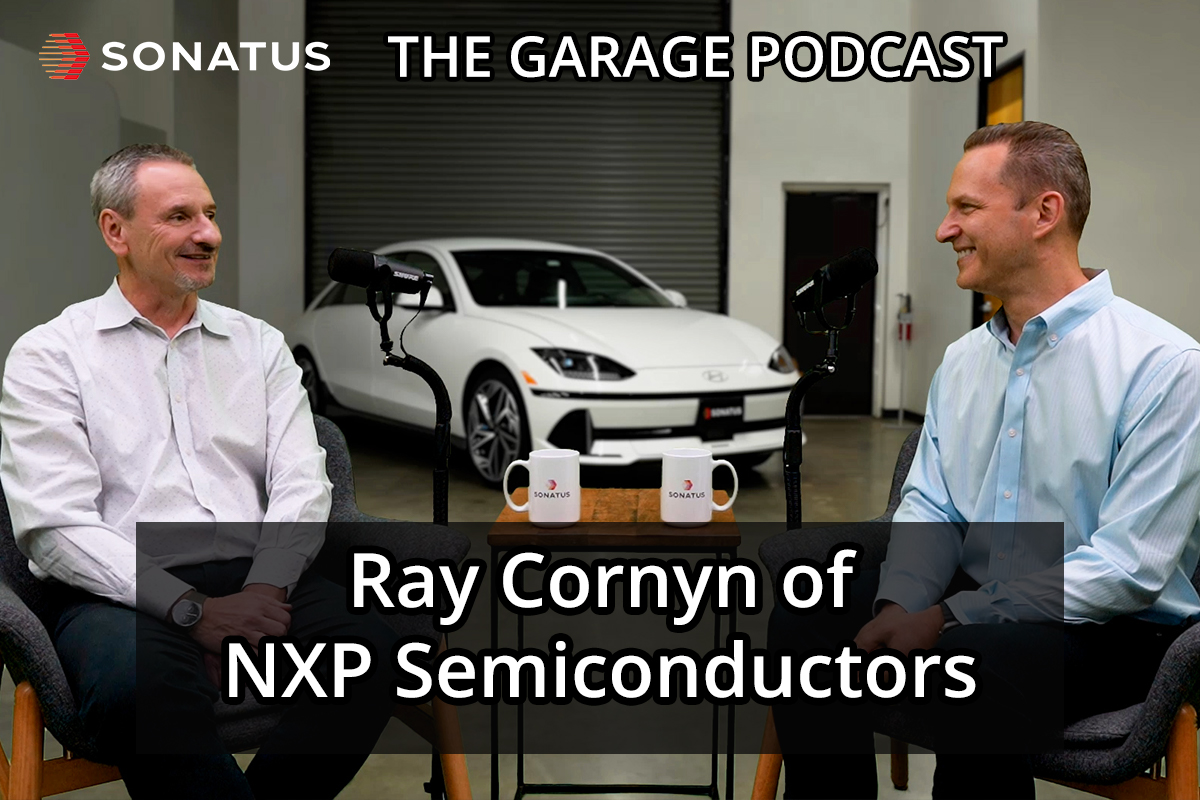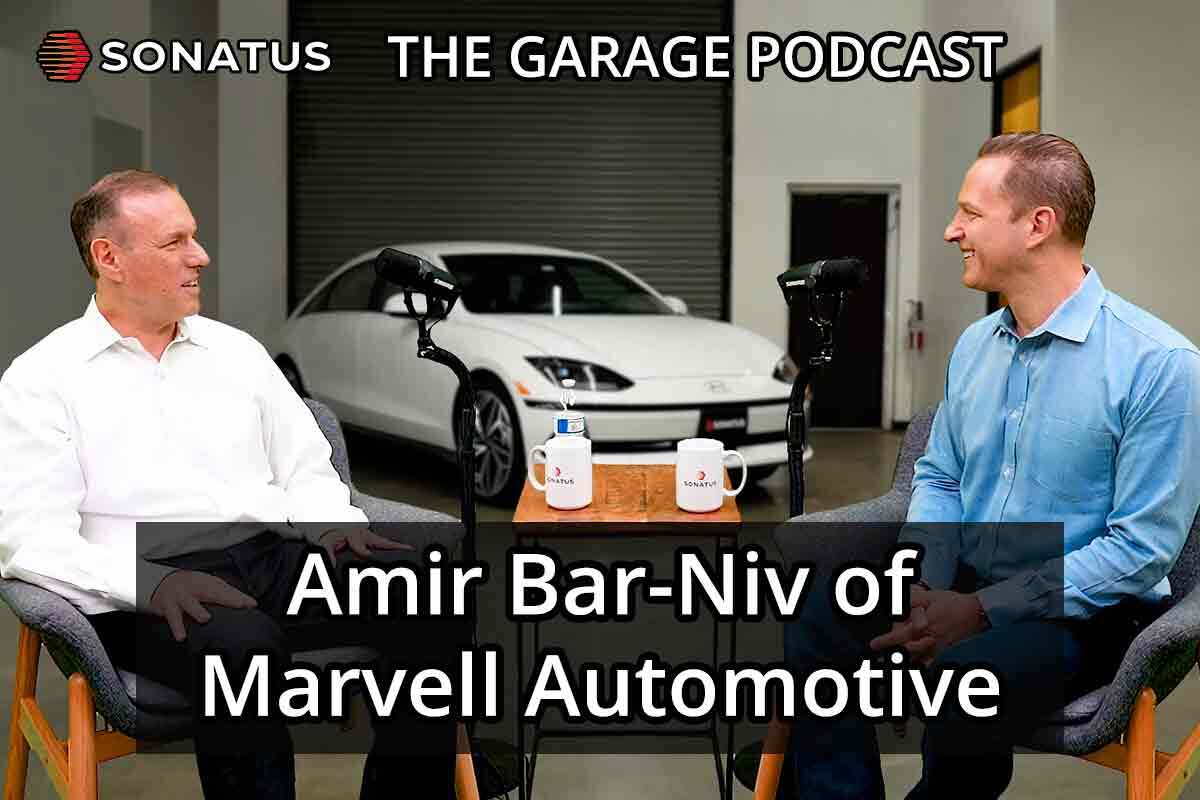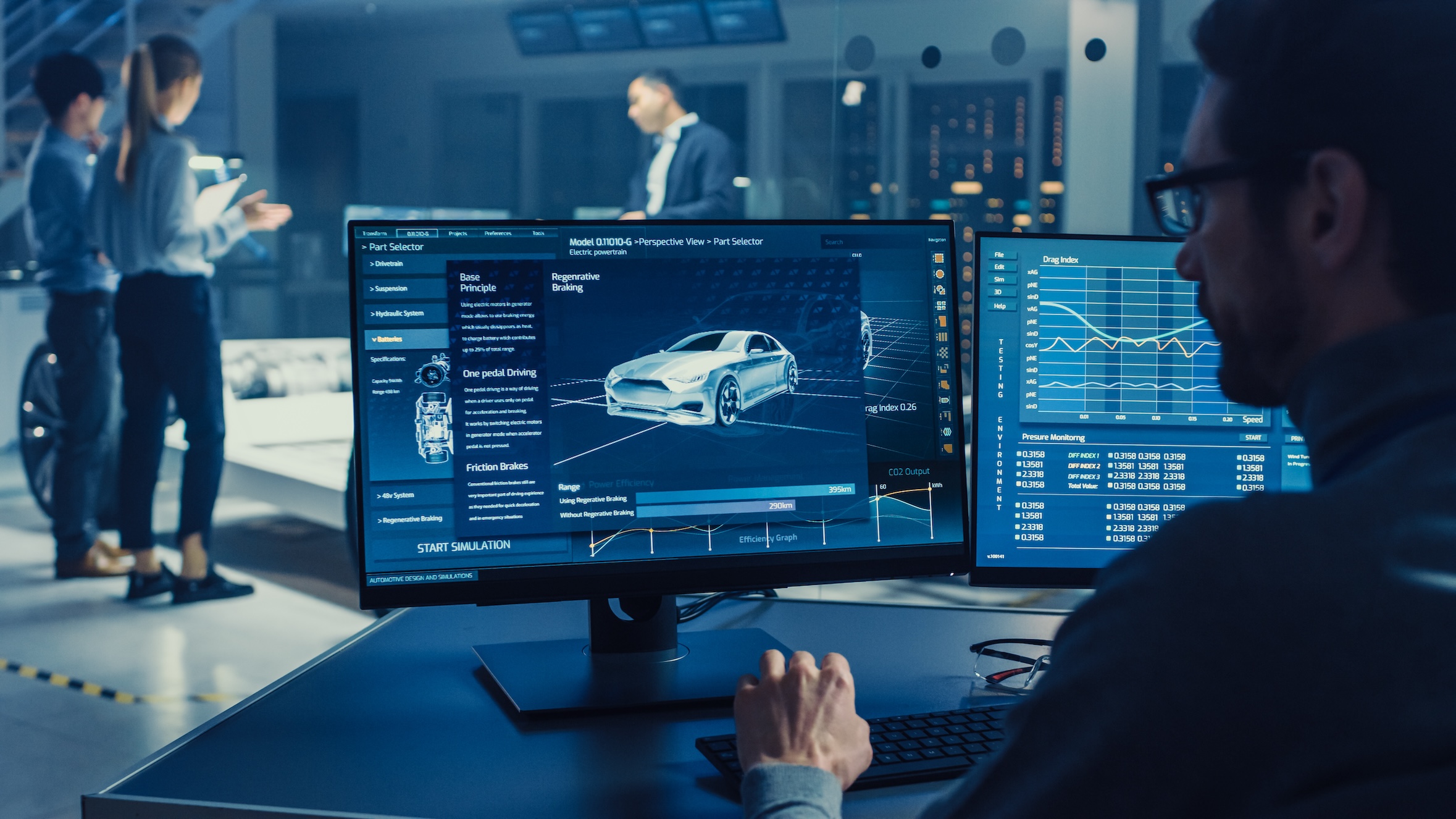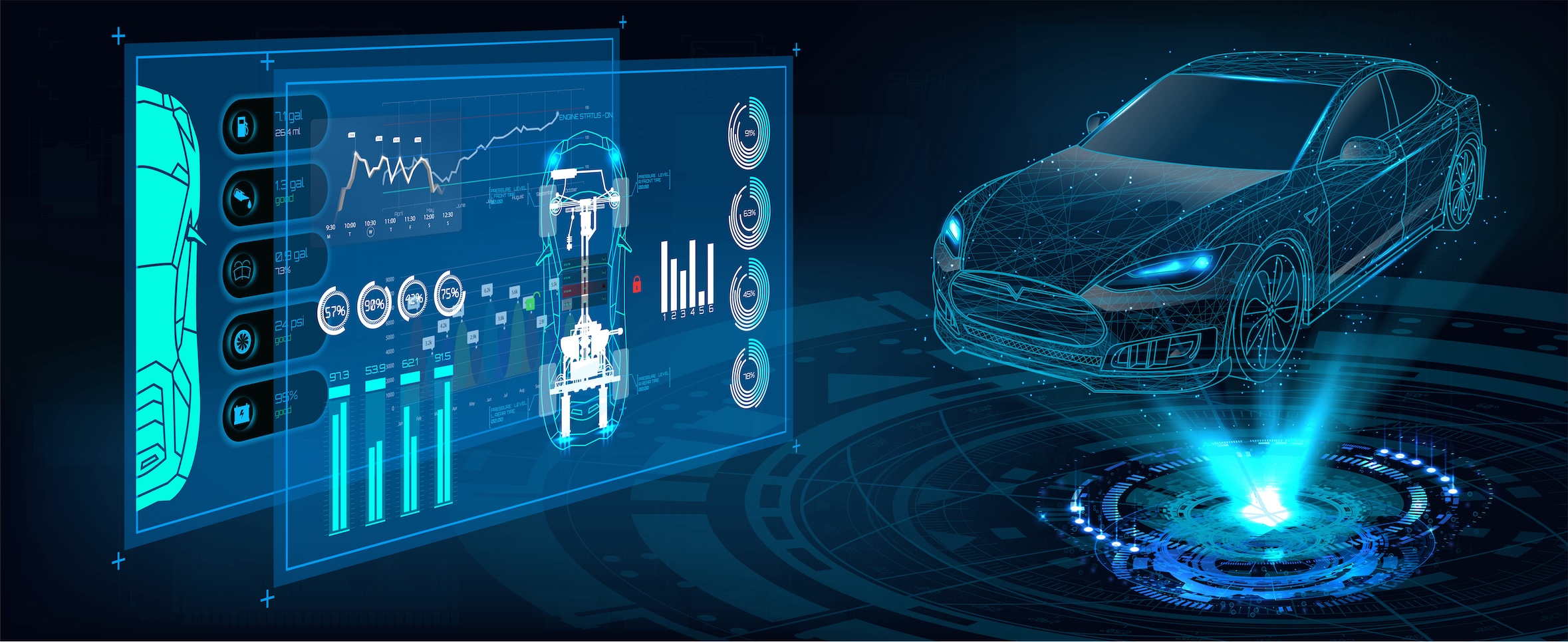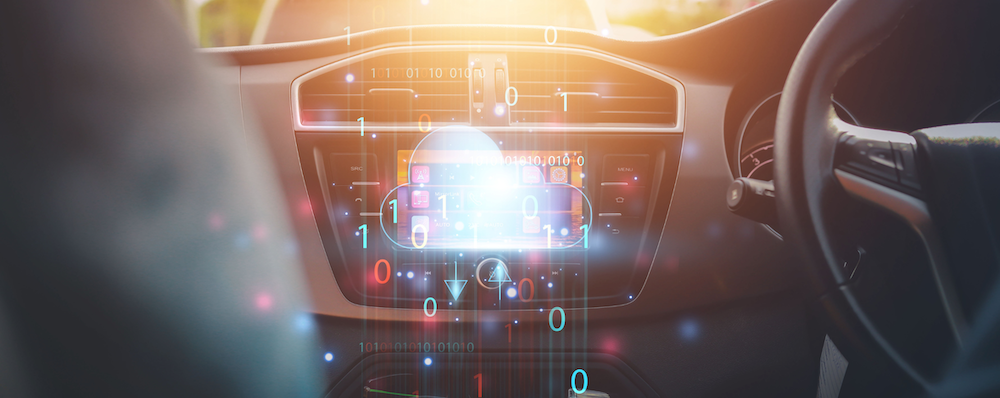Overview
JOHN: Today in The Garage, we’re recording live from Auto Tech Detroit 2024, and we’re talking about connected cars with BMW North America. Let’s go.
JOHN: Welcome to The Garage. I’m John Heinlein, Chief Marketing Officer from Sonatus. We’re recording live from Auto Tech Detroit 2024. And today we have a special guest from BMW North America, Dr. Oliver Rumpf-Steppat. We’re going to talk about connected cars. Oliver, welcome to The Garage.
OLIVER: Thanks for having me.
JOHN: Nice to meet you. We always like to have our guests introduce themselves. So tell us a little bit about you and your background.
Meet Oliver Rumpf-Steppat
OLIVER: Well, I’m Oliver Rumpf-Steppat. I’m in charge for infotainment, driving dynamics and connected drive in the US. Basically taking care of all the requirements and the validation and the operations of the whole connected drive fleet that we have in the US with over 1 million cars. I came here after working a while, over 25 years, in Munich for BMW. I came here to BMW NA, which I really much enjoy, so I zlocalized here and I stay here.
JOHN: That’s fantastic. And so, and maybe… We always ask a fun fact about our guests. So you have a German background. You’ve been in Germany for a long time, but you live in New York.
OLIVER: stay in New York, yes.
JOHN: Yeah, the state of New York. That’s fantastic. So I mean, my fun fact for the day will be– everyone wonders– I have a German last name, and they… Everyone starts speaking German to me.
OLIVER: (Speaking German)
JOHN: Exactly. Unfortunately, it’s been 100 years since my family doesn’t speak German. So we have to do English today.
OLIVER: I’m fine with that.
JOHN: And so there’s my fun fact of the day.
OLIVER: Okay.
Oliver’s role at BMW NA
JOHN: Well, so tell us about your responsibility at BMW and what you’re working on.
OLIVER: Well basically, you know, all the vehicles are mainly developed in Munich, Germany, but there are quite a few things that are U.S-specific, and we try take care of that. Like the U.S. customers like certain things special. There are special regulations. Streets are special. There’s satellite radio, which is only in the U.S. So we take care of all the requirements that we have to ask Munich to put into development, but we also take care of the implementation and the validation of those things. That’s the major part of my responsibility for infotainment and for driver assistance systems. And in addition, I’m in charge for the connected drive operations in the U.S., we are operating call centers in the U.S., and making sure customers get the help if they need it.
JOHN : Oh, that’s great. So it’s really, it’s not only localizing requirements, but also operations involved in that. That’s fantastic.
OLIVER: That’s really a very interesting part of that job.
“Sheer Driving Pleasure”
JOHN: That’s great. Well, I’m a huge BMW fan. I’ve owned a couple of BMWs. Currently I have a BMW X1, which I like driving in the mountains. It’s a good fun car. But I remember the first time I drove a BMW that I, my wife said, you should you should try BMW. She had owned a BMW in the past, and I had owned other cars. And she said, you should try it out. And I was shocked because I drove an SUV. I had an X5 for a long time and it’s a very big car. It’s a very tall car, but it drives like a sports car.
OLIVER: It is.
JOHN: And I was very surprised and I just fell in love with it immediately. And I bought one right away.
OLIVER: I think that’s something special about BMW. You have to drive those cars.
JOHN: Yeah.
OLIVER: Oh, you look at them. They’re looking great, but they drive even better.
JOHN: Yeah, once upon a time– I don’t think it’s your current slogan–- but it was, “The ultimate driving machine.” That used to be your slogan. And I thought, oh, that’s nonsense. It’s totally true!
OLIVER: It is.
JOHN: It really feels like nothing else.
OLIVER: And it’s “Sheer driving pleasure.” That’s the new slogan.
BMW investment in software
JOHN: Oh, I like that even better. But yeah, it’s absolutely true. So that’s my free endorsement. But it’s… I totally mean it. I really love it. You know, software has been, a growing important focus for the industry. Here at Auto Tech, SDV is a major focus of the conversation. They have an entire track on software-defined vehicles. Tell us about, you know, BMW’s focus on software. I know that it is a huge investment in software you’re making.
OLIVER: Right. So we started developing software in-house quite a few years ago. We have, I don’t know how many thousands of software developers worldwide. It’s not only in Portugal, in Munich, in China, in India. And we started doing more and more features in-house instead of just sourcing them from suppliers, because we are creating something very special about BMW, for example, the HMI. And we do those software parts in-house, and we combine it with software that we’re buying in.
JOHN: Right.
OLIVER: And we’re trying to be attractive for software engineers. So that’s why we founded in the beginning BMW Car IT, a small company that BMW owned, that was very attractive for computer science engineers. And this grew and grew over the years.
JOHN: That’s great. And so you have thousands of engineers doing software in BMW today. That’s great.
OLIVER: That’s, I don’t know the exact number, but it’s a lake.
JOHN: I think every OEM across the industry, you’re hearing a shift, you’re seeing a shift where OEMs are trying to bring software development in-house. Of course, there’s tier ones remain important, no doubt. But I think historically software– a lot of software– was kind of outsourced to tier ones effectively, but you’re seeing a shift towards more development in-house. So it’s great to see BMW taking a lead and doing a lot of development there. It’s very impressive.
OLIVER: I’m convinced it’s the right way. You have to find a balance in the partner network, what’s in-house and what’s outside of BMW.
BMW Connected Drive
JOHN: So you’re responsible for BMW’s Connected Drive operations in the US. I wonder if you could tell us about connected drive and kind of some of the important aspects of it that are important to you.
OLIVER: Connected drive… BMW has done Connected Drive for quite a while. I don’t know how many years, but we started with connected drive when it comes to safety, aspects like the automatic collision notification. If an airbag deploys in the car, you’ll automatically get connected to our call center. There is a voice connection established with the customer that’s in the car. We’re trying to get voice. We’re trying to get information about what’s happening there or how many people are in the car. How many passengers are in the car? What the injuries are. So that it can inform the paramedics right away so that they’re getting to the place of the accident prepared. That was the start. And after that, we introduced several other services. We had a concierge call. We still have traffic information that’s connected on the connected drive.
Sometimes a lot of drive assistance systems were, communication-wise, under the umbrella of Connected Drive, which is not the case anymore. We have Connected Drive as a part of the vehicle delivery to the customer. It’s free for four years. After that, you just have to renew. And we combine it with additional subscriptions that are coming up now.
Driver’s choice of engine type at BMW
JOHN: So I know BMW has made a big commitment to a diversity of engine types. Of course, you have incredible ICE engines, but you’ve also rolled out a number of very impressive EV models, as well. And I think you’re doing a lot of other connected services special for EVs as well. Can you tell us a little bit about your roadmap for EVs and what you’re doing there?
OLIVER: I’m not sure about the roadmap, but we’re doing a lot of special things for EVs especially. For example, if you’re on a road trip and you have a car with a stage of charge, and the battery, and navigation system will lead you right away to the charging stations on the way on the route to your destination, so that you don’t have to wait for 1 hour or 2 hours to charge your car. But you get charging breaks like ten minutes, 15 minutes, 30 minutes, whatever is appropriate. So it gives you a nice travel experience when you go there. I agree it’s not like if you’re driving with your car 500 miles in one piece, but you have some breaks, which is, by the way, very healthy. And that’s something we do for EV. We also try to prepare the car for charging stops like the battery’s preconditions. Those are things we’re doing for EVs. Especially when we go on the road trips. In addition, BMW supports wall boxes for your charging at home, which in our perspective, as far as we know, is the main use case for every customer besides charging at the company when you’re at the workplace, a lot of people, most of the people charge at home.
JOHN: That’s right. There’s a ton of conversation this week about EVs, the shift to EVs, and the infrastructure required. So just on your last point first and then I’ll go backwards. You know, having home charging is critical. And I think that we are seeing that roll out more and more across the U.S., I’m sure across other places. So that’s great. And then as far as the driving experience, yeah, that’s very important. I drive an EV myself today and having it integrated into the car to, you know, help your charging experience on longer trips, which frankly, you don’t have to charge on trips most of the time. But on a long trip you do, it makes it really seamless experience.
OLIVER: And it’s important.
JOHN: It is. And the charging network, certainly on highways and the kind of places where one would typically want to take a charging break is really expanding in the US. And I think it’s going to only continue to grow in the years ahead.
ICE, EV and Hydrogen
OLIVER: That’s right. I completely agree. The question is, what are the legal boundaries that we have to fulfill? So at the moment, a lot of governments in the world require, you know, the stop combustion engines at some point of time. We’re not so sure whether that stays that way or whether that changes. We’re trying to follow the market. We try to give the customer the power of choice.
JOHN: Right.
OLIVER: That’s what our CEO said. We’re trying to support combustion engines as well as electric vehicles. We are also investing in hydrogen as another alternative fuel.
JOHN: Yeah. It’s true. Hydrogen is often not talked about as much, but I think hydrogen will absolutely have a place. You know, I think there are certain types of vehicles in certain situations where being able to refuel rapidly will be extremely beneficial. You know, for most people, actually EV is a great choice, although not everybody knows that yet. But I think hydrogen will have a place and, so it’s good to hear that investment. I didn’t know that.
OLIVER: No, we have a fleet running in the US with hydrogen cars.
JOHN: That’s great.
EV driving experience
OLIVER: And by the way, EV’s driving behavior, it’s fantastic. The acceleration is– the instant acceleration is– is phenomenal. And most people that I know that started driving EV don’t come back to the combustion.
JOHN: I’ve been driving EV for, you know, quite a few years now. And I’ll tell you it’s very hard to go away from it. You miss it when whenever you’re driving a gasoline car.
OLIVER: I hope you’re driving BMW. We have great cars.
Connectivity in the US
JOHN: I really appreciate it. You and I serve on the Auto Tech advisory panel. You know, this is an amazing event we’re at. And, I wonder, what are you seeing around the show? We’ve had many conversations around, some of the important shifts in the industry, particularly around software and software-defined vehicles. What are some of the things you’re seeing at the show, and you’ve been at the conference sessions as well?
OLIVER: I think there is a common trend that connectivity is one important pillar that we have to consider, in the future, especially in a country like the U.S, where you have a lot of areas where we lack connectivity because there’s no coverage. You have to find– as an OEM– have to find a way, utilizing connectivity at the same time, supporting the features without connectivity.
JOHN: Right.
OLIVER: That’s something you always have to take care of. I think we’re doing a good job there. But also that the complexity of the features is getting higher and higher in the vehicle so that we have to… I like to avoid the word “educate,” but basically to take the customer with us on the journey that his car is not only a vehicle as it used to be 20 years ago, but you have more features, more possibilities in your car, and we try to keep the car fresh over time. So it’s not only your buy a car once at a time, but after a while you may have the possibility to subscribe to something. You get new features on your car so that the redesigned car looks fresh even when you sell it again to the next customer.
JOHN: And that’s right. So many important things you just mentioned there. First is connectivity. All of the major U.S. cellular providers are sponsors of this show. And so it’s definitely very important to understand how vehicle connectivity is evolving and improving. But then you also said something really important, which is as we talk about connected vehicles and, you know, there’s a big trend of cloud native design where having the cloud connectivity allows you to do very impressive things, but you can’t always rely on it, so you have to design it in such a way that the vehicle can be independent of the cloud. But when you are connected, you have additional opportunities to move compute into the edge or into the cloud. So I think that’s a really important opportunity. And then, as far as ongoing services, you mentioned upgradability. That’s a topic of almost every conversation is one of the huge benefits of software-defined vehicles is the ability to provide not only services, as you mentioned, but just more generally, upgrades and,improvements over time. It’s something Sonatus is working on as well. We think that’s very important. And having that kind of, you know, flexible foundation under the vehicle to anticipate that future is critical. So I think that’s a really great observation.
Vehicle upgrades over time
OLIVER: I agree with you. And BMW has a history of, upgrading the vehicles. We deliver three upgrades a year already and we’re working on doing this more frequently, but it’s also keeping the balance between keeping the car fresh, giving the customer new features, and don’t overwhelm him with changes he doesn’t anticipate. So if you drive a car and you park it at night and the next morning you get into a car, you’ve got the software upgrade in the car, and the car behaves totally different? That’s not something we pursue because that, the customer would not appreciate.
JOHN: Right. Yeah. It has to be a gradual path and a natural evolution over time. And I’ve seen it. It’s so interesting. I’ve seen many feature upgrades in my car, and what you see is there are always sensible changes that make the experience better. And you’re like… They were almost… They were reading my mind because now it’s something I was hoping would happen and it works better.
OLIVER: Then we did it right.
JOHN: I know.
OLIVER: Thanks for the compliment!
Vehicles are not smartphones
JOHN: I know, and I think that’s the kind of experience that customers have come to expect in their mobile phones. I think a lot of times people say vehicles are a smartphone on wheels, and we really disagree with that. More like a data center on wheels. But the idea of taking the upgradability of a mobile phone is a helpful thing to think about, because customers absolutely expect their mobile phones to get better. And I think more and more they’re expecting their cars to get better. Yeah, okay. The underlying driving experience is still there. But from the screen, from the features, from other capabilities, they’re anticipating and growing capabilities over time.
OLIVER: That’s something we have in common with the phone industry. But there are other things where we are different because customers expect everything to work perfect. And that’s the hard part of business.
JOHN: That’s right.
OLIVER: They don’t accept glitches that they used to accept on their phones.
JOHN: That’s right. Yeah, we totally agree about that. And that’s why we strongly reject the idea of a smartphone on wheels. Because your smartphone doesn’t work, you reboot it and you’re good, but you don’t want to reboot your car driving down the highway.
OLIVER: It might not be the best experience.
JOHN: Yeah, yeah. And that’s why there’s so much focus on safety certification and, and safety isolation in vehicle systems. And that’s why as the vehicle evolution, the architecture evolves, we’re going to see this partitioning of safety systems and non-safety systems that will continue over time. And we’re trying to bring– Sonatus is trying to help bring– some of that expertise of workload isolation from data centers into vehicles as well. So it’s one of the things we work on. I know you were on the panel yesterday at the show. Tell us some of the things you talked about in that panel.
BMW app store
OLIVER: Obviously, connectivity, which I mentioned already. You know, that we started to bring up a third-party app store in the car that enables the world programmers to develop apps for the customers. And that can be sold, can be subscribed to in this third party app store that we offer in our head units in the latest generation.
JOHN: That’s great. So another example of how vehicles can be extended with additional capabilities.
OLIVER: And it’s a slow-growing business at the moment. It’s still in the in the… How should I say it in English… challenges, like in the beginning.
JOHN: Sure.
OLIVER: But I think I’m convinced this will grow over time. And there’s a lot of opportunities coming up.
JOHN: Yeah. I mean understanding the point we made earlier about safety and of course that we’re talking about maybe entertainment experiences, not safety experiences. The fact is, I think that kind of expansion of app and experiences in vehicles will only grow. Particularly as autonomous driving levels increase and people are able to take their attention off the driving experience over time, maybe not so much today, but in the years ahead. I think it’s a great investment for the future.
OLIVER: There are some opportunities. At the same time, we have to make sure– and this is the provider of the third-party app store– that things are safe, don’t distract the driver too much and follow rules. And at the moment we don’t see any level three or level four driving on the streets coming up too soon.
JOHN: That’s right.
OLIVER: Even though there are some cars on the way.
JOHN: I agree, I mean, you know, you’re seeing some, you know, level two plus maybe some limited level three deployment. But that’s still in front of us. And so I think it’s a journey for this app store model. I mean, I’m reminded that when the iPhone first came out, the App Store was very rudimentary and very limited. But in the years ahead, it’s become a, you know, a billion… Multi-billion dollar, I think it’s over $1 trillion of value created by the App Store from phones.
OLIVER: Yes.
JOHN: And I expect over time that same kind of thing will extend into vehicles over time.
OLIVER: Could be. Could be.
Conclusion
JOHN: Well look, Oliver, it’s so wonderful to have you join us at Auto Tech. It’s great to work with you on the advisory panel for the show. And, thanks for your help there. And, we appreciate you spending time with us.
OLIVER: Thank you very much for having me here. It was a great time. Thank you.
JOHN: If you’re enjoying these episodes, please like and subscribe and join us for future episodes in The Garage. We have many other episodes from Auto Tech Detroit, and we’ll be seeing you in another episode again very soon.
